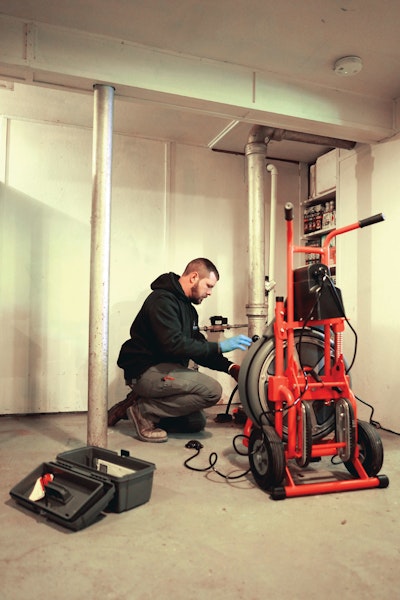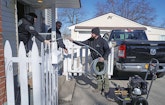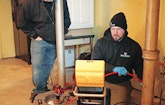
Michael Reed watches progress on the monitor of a Vivax Metrotech vCam MX2, while using a RIDGID K9-204 FlexShaft machine to clean a basement drain.
Interested in Plumbing?
Get Plumbing articles, news and videos right in your inbox! Sign up now.
Plumbing + Get AlertsBuffalo, New York, is old and cold. The city dates from very early in the 19th century, and its average January temperature is slightly below freezing. Michael Reed takes it all in stride for two reasons: He’s a Buffalo native, and he’s a plumber. Cold can be good for business.
“It was 8 degrees F yesterday morning,” he said during a February conversation. “We don’t get long stretches of bitter cold, maybe two or three days in a week. But then it warms up into the mid-30s, pipes thaw or burst, and I get slammed with calls. It happens often, usually because a basement has a window or there’s poor insulation in a wall.”
Reed owns Big Dawg Plumbing & Backflow, a one-man shop he opened in 2017 that is steadily growing into a standard of excellence in the city and surrounding Erie County. The company’s success isn’t all from frozen pipe calls, either. Reed is building his business on three things: plumbing new houses and remodeling old ones, testing backflow devices and personal integrity.
CALL THE BIG DAWG
Reed served in the U.S. Marines and was looking for a job in 2007 when he visited family-owned Hertel Hardware & Plumbing in Buffalo. He inquired about working there, and the owner asked Reed if he knew Matt Valentine.
“Sure, he was my platoon sergeant a few years ago,” Reed told him.
“Cool. When can you start?”
Name-dropping and respect for military service — if only all jobs were secured so easily. Reed made the most of it. He signed on and worked at Hertel Hardware for nine years. He ran the service department for six years.
“If there was a question from a customer — some question about the plumbing equipment or how to tackle a difficult task — the service guys would say, ‘Better call the big dawg.’ Pretty soon I changed the caller ID on my phone to ‘Big Dawg’ as a joke. Then customers started calling me that as well. Before long, everyone knew me as Big Dawg.” When he went into business for himself in 2017, Reed made it official: Big Dawg Plumbing & Backflow was born.
Two years ago, he brought on a second plumber to help him meet the demand of customer calls. Before long, Reed had to let him go.
“My biggest thing with customers is to try to be honest and upfront.” Unfortunately, his lone employee “didn’t exemplify that,” he says. “I’ve found that if you are honest and very direct, not feeding them any garbage, they become comfortable with you doing your work.”
An honesty policy is clearly working for Reed. The calls keep coming. “At the moment, I’m OK working by myself, but it’s getting to the point where I am going to have to hire someone. I’m getting extremely busy.”
REPLACE AND REPAIR
The “old” part of the city’s character is apparent in its infrastructure. Many of the sewer mains in Buffalo are formed of bricks rather than clay, concrete or plastic sections, which means they are subject to more leaking and inflow. Most laterals on residential property are fabricated of vitreous clay. Across the western New York region, communities small and large are struggling to have their sewer pipes lined or replaced with PVC pipe, some of that in response to consent orders from environmental protection offices.
Big Dawg Plumbing & Backflow captures its share of the leaking laterals and drainpipe work. Reed inspects pipes with the company’s Vivax-Metrotech MX2 video cameras and cleans them with RIDGID cable machines. He also wholly replaces damaged laterals. Because replacement requires excavation, for such jobs he reaches out to D’Amorie Construction — owned by a friend in nearby Blasdell.
D’Amorie Construction got the call recently after a property owner contacted Big Dawg Plumbing & Backflow to complain about a blockage in a sewer lateral. Reed sent the MX2 into the line and watched it disappear below backed-up water. Subsequent investigation revealed that a faulty city project was to blame.
The city had hired a subcontractor to line a sewer main in front of the house with a cured-in-place product. Unfortunately, during the in-pipe reinstatement process that gives laterals access to the pipe, the robotic cutter miscalculated and only exposed 1 inch of the 6-inch-diameter lateral opening.
Reed was contracted to replace the pipe and reestablish a link with the main. After D’Amorie Construction opened a hole at the house end of the pipe, Reed inserted a 4-inch PVC pipe into the 6-inch old line, doing 10-foot sections at a time. At the bottom end of the line, another hole was opened so he could connect the new pipe to the opening in the sewer main. The whole project took about five hours. “The customer got a brand-new sewer line, and the town paid for it.”
IN THE ZONE
The 32-year-old company owner holds several master plumber licenses — in New York, the licensing is done by local jurisdictions. Though he takes on some commercial jobs, Reed is most comfortable remodeling houses and apartments and plumbing new residential construction. He says he likes working with contractors and with the variety of customers who call with home plumbing problems. “I’m in my zone dealing with new people,” he says.
Remodeling work generally claims the biggest share of his working time, though last year new construction claimed as much. He had witnessed a “lull” in economic activity in the city center as companies moved away and commercial buildings were vacated, which was followed by a surge of new construction in 2019.
“Not-so-great neighborhoods are up and coming; empty buildings are getting occupied again. I’m getting a lot of remodels and newbuilds. I’m not the cheapest guy, but people see they are getting quality work.”
Plumbing newly constructed residential units can be cold work during the winter, but there is little choice: Construction is done seasonally, Reed says. “What happens is they get the foundation in during the warm months and it’s October or December before I can get in to plumb.”
In those new residential builds, Reed enjoys installing exotic shower systems with multiple body sprays and touch controls, some with a waterfall and a Wi-Fi system. “That would be my favorite job — high-end showers. I’m getting quite a reputation around here for installing them.” Case in point: When another plumber recently failed to get a fancy shower working, Reed was called to finish the job.
FINDING A NICHE
Another strong component of Big Dawg Plumbing & Backflow work is testing and replacing backflow devices. The devices are placed on waterlines to prevent inadvertent flow of water from a possibly contaminated source into a clean-water supply. Reed cites the example a few years ago of leakage from a residential waterline in a cul-de-sac after its device failed. Everyone living on the dead-end street was infected by a bacterial agent that backflowed from the home’s water supply into the mainline where it traveled to neighboring homes.
Two types of backflow devices are used to prevent this: a double check valve assembly, or DCVA, and a reduced pressure zone, or RPZ. The DCVA has two springs, each engineered to resist a pound of water pressure and keep a valve cover closed against backpressure from a private line. The RPZ contains a differential valve as a final defense against bad water incursion.
“I was working with Hertel Hardware in 2013 doing a lot of commercial remodeling and the water authority told us we needed to have the backflows tested when we installed them. That got me to questioning about the devices,” Reed recalls. He learned that an organization called the Cross Connection Control Foundation teaches how to install and test the devices. Reed took a week off from work to take the class. It was an investment of time and money.
“You have to pay a hefty fee to enroll in the class and a hefty fee to buy the testing gauges,” he says. The investment has paid off, however. Today, about a quarter of his business revenue is produced from backflow jobs and that percentage could grow: Backflow testing presently is required only for commercial connections, but some New York authorities are pressing for installation and testing of residential lines, too.
“It’s not a very high moneymaker at first, but once you build up your clientele, it’s a steady income,” he says. Annual inspection of the devices is required by law, and that generates return customers. Reed estimates one in 20 of the tested units needs replacement and one in 10 needs repair. Some jurisdictions have begun to require that repairs must be done by a plumber with a master license and a testing license, but that’s no problem for Reed.
Half of the company’s backflow clients are Reed’s regular customers; the other half are customers of other plumbers who call him to do the work for them. When a device fails the test, a property owner has 30 days to fix or replace it. Reed’s report goes to the health department, which follows up with a call to the water user. Or Reed follows up. Either way, he usually gets the call to make things right with the device.
COURTEOUS SERVICE
Given Reed’s wide variety of work, he’s become adept at swapping out tools in his GMC Savana truck to support the work of the day. For a repair run, out go the Vivax-Metrotech inspection camera and his RIDGID cable drain machines — he has five, including a K-7500 drum machine and K-45 unit for smaller drains — and in go his chop saw and assorted lengths of PVC pipe. His newest piece of equipment is a custom-built jetter from Amazing Machinery. It’s a 4,000 psi, 4 gpm jetter with a 150-foot hose and RIDGID Root Ranger nozzle.
Though he advertises 24/7 service, Reed happily reports that the midnight calls seldom come. “People are pretty good about it. They don’t call in the middle of the night unless a floor is flooded or a water heater blew. They wait till morning.”
The courtesy extends to cutting Reed some slack when his own emergencies come up — such as when his wife, Meagan, gave birth to their second child, Isaiah. He called about a dozen customers whose work had been lined up for the following few days and said he would have to reschedule his visits. “‘Oh, my goodness,’ they said. ‘Call me when you’re free. I’m not calling anybody else.’”
Expanding into PEX
Copper used to be king in waterlines with residential and commercial water systems mostly being fabricated of copper pipe in the last half of the 20th century. Galvanized steel pipes also held a dominant position in the waterline world. Both are being dethroned by plastic lines. Michael Reed works with all three types of pipe in his plumbing work in the western part of New York state.
Reed operates Big Dawg Plumbing & Backflow in Buffalo and surrounding Erie County. The older housing stock in the city contains lots of galvanized and copper pipe, and Reed says he works with copper lines three or four times a week. “Copper drainlines not so much, but there are plenty of copper waterlines.”
Galvanized pipe tends to leave discoloration in porcelain sinks, and it eventually rusts through and leaks. “When the galvanized pipe clogs up or rusts, we take it out.” The same goes for copper. Reed replaces the failed metal pipe sections with PEX — cross-linked polyethylene — a flexible and durable plastic tubing. He generally utilizes PEXa, which can range from 1/2 to 4 inches in diameter and is certified for use on potable water lines.
The tubing has the virtue of being expandable, swelling up to three times its normal size. In a city situated on the U.S.-Canadian border and subject to freezing weather, the peril of waterlines being fractured by frozen water is real. The flexible plastic is extra assurance against the threat.
Reed uses the tubing in remodeling jobs — when a bathroom is being enlarged, for example, and lines are moved or lengthened — as well as in new construction work. Anywhere there potentially will be freezing temperatures — such as in the crawl space under mobile homes or in uninsulated basements — PEX waterlines are the rule.
Codes specify copper pipe in some cases, however, and sometimes replacing old copper with new copper makes sense. In those cases, Reed breaks out his torch, striker, solder and flux and goes to work like plumbers have for a long time. “I always keep my torch on the truck.”










